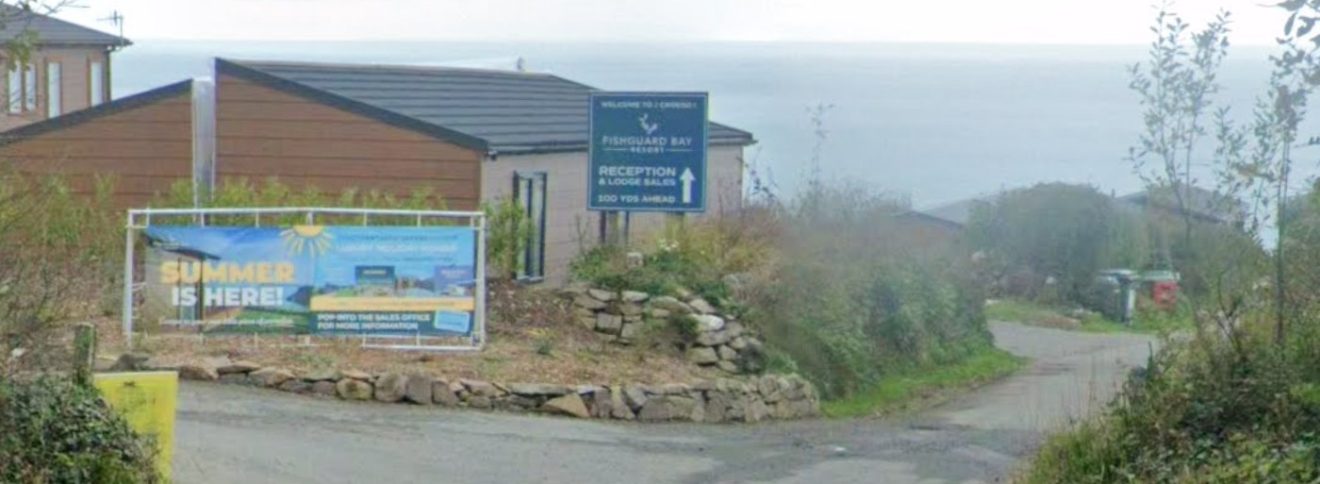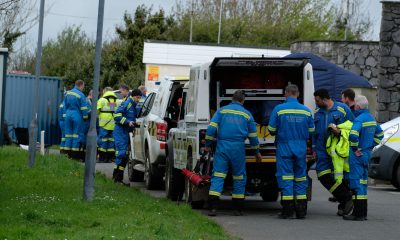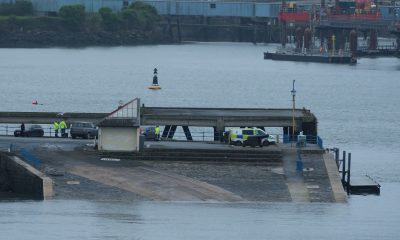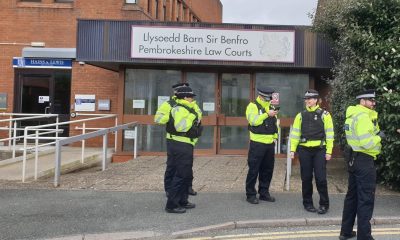News
Traffic problems leave locals livid
 ANGRY residents of Lower Thornton in Milford Haven fear for their safety because of the heavy volume of traffic travelling at speed near their homes.
ANGRY residents of Lower Thornton in Milford Haven fear for their safety because of the heavy volume of traffic travelling at speed near their homes.
Lower Thornton has no pavements and properties face out on to the narrow stretch of carriageway. Residents complain that between 6.30am and 9am every day, the road through the small village is being used as a ‘rat run’ by drivers, and has been since the closure of Murco Refinery.
After consulting Pembrokeshire County Council (PCC) and Dyfed- Powys Police, they feel as though they still have not got anywhere with the issue, and instead turned to The Herald for help.
The Herald spoke with many residents from Lower Thornton, who are very angry with the local authorities. One of the locals, Mr Sam Hassan said: “The measures in place to reduce the speed of vehicles through the village of Thornton are ineffective.
“There are speed bumps along the road that have been there for around eight years, and they are very worn, and they are so small that vans can pass over them without their wheels touching.
“The bumps do nothing, and the speed the vehicles are travelling at is a hazard, and I feel our only solution is to have a speed camera.”
Mr Hassan added: “I bought myself a high visibility jacket, because I was frightened of being hit by a car when I walk my dog. The price is that someone needs to be killed before action will be taken.”
The speed that vehicles should be travelling at through Thornton is 20 miles per hour, although it is not illegal for people to drive faster than that, as it is only an advisory speed. However, the 30 miles per hour limit is compulsory.
And, with the mistake of the houses in Lower Thornton being placed too close to the road, the issue of having no pavement is a difficult one.
The residents say they understand that a footpath is difficult, but wish to receive some sort of traffic calming measures that would be effective for the village. Resident Glen Gale told The Herald that he even witnessed one of his neighbours being hit by a speeding car in Thornton when on her way to the cemetery, to take flowers to her recently deceased husband.
Mr Gale said: “People are speeding with elderly people around and children walking to school. There’s no refuge and there’s no respect for anybody.”
ARE SPEED CAMERAS AN OPTION?
The Herald contacted Dyfed- Powys Police to ask whether introducing speed cameras was an option. They said that the issue of speeding in the Lower Thornton area has been raised with police and has been a PACT priority.
They also said that officers have conducted speed checks at the location on a number of occasions with no one found to be over the speeding limit to date.
However, after contacting PCC, it came to light that the latest traffic count was conducted in October 2013, before the closure of Murco and before the opening of the new bypass from Tiers Cross to Johnston.
A spokesperson from PCC said: “A 20 mph zone was introduced in the village of Thornton in February 2008 following concerns raised about refinery traffic using the road through the village. The zone includes 11 pairs of traffic calming cushions spaced at regular intervals through the village.”
Resident, Hazel Davies and her husband, Tony, said they had even seen arctic lorries passing through the village, who were also paying no attention to the traffic signs, or the 7.5tonne weight limit for the bridge over the village.
PCC said that in addition to the 20 miles per hour zone, the County Council introduced a weight restriction on the road in June 2002. This restriction prohibits goods vehicles exceeding 7.5T except for access.
In response to claims of an increase in traffic since the closure of Murco, PCC said: “The refinery has now closed with the facility being used for oil storage purposes. As a consequence, this should have had an impact on traffic flows through Thornton. The completion of the nearby Bulford Road should also have had a similar effect on local traffic flows through the village.
“Pembrokeshire County Council has undertaken a number of traffic flow counts in the village with the last one carried out in October 2013. At that time the average 24 hour 2-way flow was 1132 with average daytime flows in the region of 100 vehicles per hour.
“The survey recorded average traffic speeds within the zone of 22.0 mph towards Old Hakin Road and 19.4 mph towards Steynton.
“The County Council has arranged to repeat this count to provide an indication of flow and traffic speed changes resulting from the closure of the refinery and the opening of the improved Bulford Road.
“This will help determine whether there is any justification to modify or amend the existing traffic calming measures through the village.
“The County Council has a proposal for a footway through the village in its forward programme pool. Unfortunately the character of the road is such that a facility of this nature would require extensive land acquisition and accommodation works.
“It is unlikely therefore that such a footway will be provided in anything other than the longer term, especially considering the fiscal pressures currently facing the Authority.”
Mrs Davies said: “We know there’s not enough room for a footpath, but anything is better than nothing.”
FEARS THAT CONCERNS ARE BEING IGNORED
Hazel’s husband, Tony, suffered a stroke around seven years ago and fears that his and neighbours’ concerns are being ignored.
When this was put to Dyfed- Powys Police, Sergeant Terri Harrison said: “I would like to reassure the residents that police take all calls seriously, especially those that impact on public safety, such as speeding.
“We have responded to concerns raised by the public either in person or by phone. We will in the near future be piloting a Community Speed Watch in Johnston and, if successful, this could be rolled out to neighbouring villages including Thornton.”
However, there is still no mention of the proposed speed cameras. It came to light that Mobile Speed Enforcement Cameras are the responsibility of the Wales Road Casualty Reduction Partnership which has a set of criteria that has to be satisfied before they can designate a site for enforcement.
This criteria involves a site assessment which considers a number of factors including speed and accident data; built environment including schools, shops and other facilities, pedestrian activity, and road function at any given location.
Requests for a site to be considered for enforcement are normally addressed to the Council who will then collate the relevant speed and accident data. This information is then passed onto the Partnership who will undertake a comprehensive review in accordance with their criteria.
The Partnership failed to reply to The Herald directly, and instead forwarded our questions to Dyfed- Powys Police, who had already spoken with us.
COULD THE ROAD BE CLOSED?
Mr and Mrs Davies said that if all else fails, then they would like to try to persuade PCC to consider closing off the road, due to the village now being used as a “thoroughfare.”
Mrs Davies said: “I don’t know where the traffic is coming from. I’d like to ask them where exactly they are going! However, I did notice that when the Cleddau Bridge was closed due to th bad weather, the volume in traffic definitely increased, which tells me the people driving must be going to and from Pembroke Dock. But why are they using Thornton?
“I think the only way to solve this is to close the road.”
Mrs Davies also said that she “knows” that large vehicles can turn around within the village, and that there should be “no reason” as to why it couldn’t be closed off like neighbouring streets, just like Bulford Road.
After leaving PCC alone for a few weeks, The Herald contacted them again to see if any progress had been made, with regards to finding out exactly how much traffic is passing through the village, and whether or not they have decided to do anything about it.
We also asked whether the proposed closure of the road, could be an option.
A spokesperson from PCC said: “A traffic survey is programmed which will enable the Authority to evaluate the current level of traffic and vehicle speeds through the village.
“The information will also enable a comparison to be made in respect of the impact the new Bulford Road scheme has had volume.
“In terms of closing the road to through traffic, the practicalities of such a proposal would need to be examined in detail and a full consultation exercise undertaken before a decision is made.
“Consideration would need to be given to a number of factors such as the impact on journey time and distance the closure would have on residents. The question as to how large vehicles – such as refuse lorries – accessing the village would u-turn would need to be addressed.”
News
Labour promises ‘most significant investment in Britain’s ports in a generation’

LABOUR has said this week that it will “Build it in Britain” with the most significant investment in Britain’s ports in a generation, as part of Green Prosperity Plan to support the creation of 650,000 good jobs across the country.
A Labour Government will “Build it in Britain” Keir Starmer said on Thursday, as he visited the North East of England to highlight Labour’s plans to deliver the most significant upgrade of Britain’s ports in a generation.
Visiting a port in the North East, Labour Leader Keir Starmer, Shadow Chancellor Rachel Reeves, and Shadow Energy Secretary Ed Miliband will set out how Labour’s £1.8 billion investment in Britain’s port infrastructure will help crowd billions more of private sector investment into the UK’s energy industry.
Labour’s announcement comes after Jo Stevens, Shadow Secretary of State for Wales, visited the Port of Milford Haven in Pembrokeshire last month alongside with Henry Tufnell, Labour’s parliamentary candidate for Mid and South Pembrokeshire, to learn more about the port’s operations and challenges.
After the visit, Shadow Welsh Secretary Jo Stevens said: “Upgrading our ports, like this one here in Milford Haven, can help us seize the golden opportunity we have to become a world leader renewable energy, delivering cheaper bills and the jobs of the future.
“But the Conservative government is holding Wales back, with narrow-minded, poorly run investment schemes that leave us lagging behind international competitors.
“A UK Labour government will switch on GB Energy to invest in projects that can secure our lead in floating offshore wind, unlocking the jobs and investment that the Tories have left to languish.”
Henry Tufnell, Labour’s candidate in this year’s General Election, added: “Pembrokeshire’s first Labour MP, Desmond Donnelly, was instrumental in the creation of the Port of Milford Haven, transforming Pembrokeshire’s economic fortunes. Today, as in the 1950s, we face a crossroads. We must put our county at the forefront of a new Labour Government’s industrial strategy to build it in Britain.
Labour’s Green Prosperity Plan will secure our energy supply, develop industry, and create good well paid jobs right here in our county. We don’t want the young people of Pembrokeshire to feel they must leave their home county to get on in life. We want to provide opportunity here, and we want to provide it now.”
Labour’s plan for ports will help reverse fourteen years of industrial decline under the Conservatives and support domestic manufacturing across the country. The pledge is funded through Labour’s Green Prosperity Plan, which includes a proper windfall tax on the oil and gas giants making record profits, to fund investment in British industries.Keir Starmer’s announcement comes as Labour confirms that its Green Prosperity Plan will help support the creation of up to 650,000 good jobs in Britain’s industrial heartlands, including here in Pembrokeshire, by crowding billions of private investment into industries such as Britain’s nuclear, steel, automotive, and construction industries.
The last Labour government led the way on upgrading Britain’s ports, providing funding for the development of port sites to support offshore wind turbine manufacturing. This industrial advantage has been squandered after fourteen years of the Conservatives, with recent research showing the UK could have created almost 100,000 more jobs in the wind industry if it had followed Denmark’s example in recent years and built up domestic supply chains in clean energy.
Speaking ahead of the visit, Labour Leader Keir Starmer outlined the choice facing millions of voters: continued industrial decline after 14 years of Conservative rule, or national economic renewal with Labour, saying:“The legacy of fourteen years of Conservative rule is Britain’s industrial strength reduced to the rubble and rust of closed-down factories. They have let good jobs go overseas and done nothing about it, and every community has paid the price.
“A Labour government will reindustrialise Britain – from the biggest investment in our ports in a generation, to a British Jobs Bonus to crowd billions of investment into our industrial heartlands and coastal communities.“
The wealth of Britain was once built on a bedrock of industrial jobs that offered security and a good wage. By investing in Britain’s homegrown energy sector, we can rebuild this dream for the twenty-first century- good jobs, higher wages, and the pride that comes from good work for all.”Through policies such as Great British Energy, the National Wealth Fund, and the mission for Clean Power by 2030, a Labour government will invest in technologies like floating offshore wind, hydrogen, nuclear, and carbon capture and storage, which will help secure Britain’s energy independence.
This will create a new generation of skilled jobs in growing industries, which will offer people good wages, give confidence in their job security, and provide them with opportunities to progress. This policy is part of Labour’s Green Prosperity Plan, to cut energy bills for families, make Britain energy independent, and rebuild the strength of British industry.
This historic investment in working people and their communities is the only way out of the high energy bills, energy insecurity, and the doom loop of low growth, high taxes and crumbling public services under Rishi Sunak’s Conservatives.Commenting on Labour’s landmark plan to invest in Britain’s port infrastructure, Shadow Energy Secretary Ed Miliband MP said: “Making Britain a clean energy superpower requires flourishing national ports. Whilst the Conservatives are letting other countries plunder jobs that could be ours here in Britain, Labour has a plan to help win the race for the industries of the future.“
This is what Labour’s Green Prosperity Plan will do for every community in Britain – slash energy bills, create good jobs, boost our national energy independence, and help to tackle the climate crisis.”
Business
Scheme to upgrade Dinas Cross holiday park withdrawn

PLANS to create a ‘five-star resort’ in one of Wales’s most popular holiday locations have been withdrawn.
In an application submitted to Pembrokeshire Coast National Park, Chester-based Boutique Resorts Ltd sought permission to relinquish 50 mixed touring pitches (caravans and tents) at Fishguard Bay Resort, Dinas Cross, replacing them with “36 high quality timber-effect holiday lodges”.
The application, recommended for refusal at the April 24 meeting of the national park’s development management committee, also included an increase in the site area of the approved park, a new entrance, a new reception lodge, staff and visitor parking area, with extensive environmental improvements.
The site, established in the 1950s, currently has planning permission for 50 static caravans and 50 mixed touring units, and it is intended 23 of the proposed lodges to be sited at the entrance, with a further 13 throughout the site.
Despite the proposals seeking a reduction in outright numbers, the applicants say the scheme would see an increase in the number of full and part-time jobs associated with the resort, from 29 to 62 jobs.
A previous application was refused in 2019, mainly on visual impact, ecological impact and highway impact, and the applicant has sought to address the issues raised by that refusal, a supporting statement says.
It adds: “The applicant purchased the site in 2014 with the intention to upgrade the site into a five-star luxury resort. This is very much still the applicant’s intention and whilst he has replaced some existing static caravans with luxury lodges, he also seeks to replace the touring caravans and tents with luxury lodges too.
“The resort is now considered one of the most desirable holiday parks on the Pembrokeshire Coast which is evident on the number of holidaymakers who return to the resort year on year. Such is demand for luxury lodges on the site, the applicant requires additional units.
“The applicant now wishes to move the resort further by replacing the mixed touring pitches with luxury lodges but also provide a much-needed new entrance into the resort.”
Objections to the scheme were received from the National Trust, the national park’s strategic policy and ecologist, and the South Wales Trunk Road Agency, and 12 members of the public, along with one letter of support.
The application was recommended for refusal for reasons including it was “likely to have a significant detrimental impact on the special qualities of the National Park by intensifying the visual impact and intrusion of a large static caravan site within the extensive coastal views of this section of the National Park,” it would represent an intensification of the site, and was likely to “have an unacceptable impact on neighbouring residential amenity through increased noise and traffic movements”.
The application, listed for consideration by park planners next week, has since been withdrawn.
News
First step towards council tax and business rate reform

MAJOR reforms to council tax and business rates have cleared the first hurdle in the Senedd.
MSs backed the general principles of the local government finance bill, which would introduce a five-year cycle for council tax revaluations from 2030.
The bill would lay much of the groundwork for Welsh Government proposals to redesign council tax, with current bands based on property values from 2003.
It would also increase the frequency of business rates revaluations from five to three years.
Rebecca Evans told the Senedd the bill forms a vital part of the Welsh Government’s wider programme of local tax reform.
Wales’ finance minister explained the bill would enable ministers to modify business rate relief exemptions and the multiplier to support policy priorities.
John Griffiths outlined the local government committee’s stage-one report recommendations aimed at improving the bill and guarding against unintended consequences for taxpayers.
Mr Griffiths explained that the bill provides a framework for future policy changes to be made by the Welsh Government via secondary legislation.
The Labour MS, who represents Newport East, said the committee heard concerns that this limits opportunity for public engagement and scrutiny by the Senedd.
Welcoming the Welsh Government’s commitment to retaining the single-person council tax discount at 25%, he highlighted wide-ranging powers in the bill over vital reduction schemes.
In terms of business rates, the committee chair said MSs heard broad support for a move to three-yearly revaluations, which he described as a reasonable, proportionate cycle.
Peredur Owen Griffiths, who chairs the finance committee, backed the bill’s key aim to create a fairer, more flexible system.
The South Wales East MS welcomed reassurances from the Welsh Government that the intention of council tax reforms is not to raise more revenue.
“Given the regressive nature of council tax, we support the aim to make it fairer without affecting the tax base,” he said.
Plaid Cymru’s finance secretary said the proposed powers will reduce the Welsh Government’s reliance on UK bills to make changes.
Alun Davies, a Labour backbencher, warned that delegated powers in the bill risk diminishing the role of the Senedd.
Sam Rowlands, the Tories’ shadow local government secretary, raised concerns about the bill putting more power in the hands of the Welsh Government rather than councils.
He warned the bill is a stepping stone towards higher taxes through the back door, saying: “This bill in and of itself does not necessarily do that but it certainly enables future changes.”
The former leader of Conwy council, who represents North Wales in the Senedd, called for reforms to the formula used to allocate funding to Wales’ 22 councils.
Raising concerns about digital exclusion, Mr Rowlands opposed a provision in the bill which would remove a duty to publish council tax notices in local newspapers.
He said: “We believe it’s a really important part of the democratic process in local government, especially in relation to transparency.”
Backing a revaluation of all 1.5 million properties in Wales, Labour MS Mike Hedges described council tax as fundamentally unfair.
He said: “Someone living in a property worth £100,000 pays around five times as much council tax relative to the property value as someone living in a property worth £1m.”
Mr Hedges, who represents Swansea East, also opposed the removal of the duty to provide council tax information in newspapers.
On business rates, he said: “I’ve always supported the returning of them to local authorities. We don’t need an all-Wales system; let each local authority set its own business rates.”
Ms Evans told the chamber she intends to make a statement on the next steps for council tax reform before the summer recess.
The Senedd agreed the general principles of the reforms without objection, and the bill now moves to stage two which will see MSs consider detailed amendments.
-

 Business3 days ago
Business3 days agoBluestone National Park Resort payments expected to end
-

 Community5 days ago
Community5 days agoThe Harbourmaster: Special rail excursion draws crowds to Milford Haven
-

 News4 days ago
News4 days agoDragon LNG ‘monitoring’ scrap car blaze in Waterston
-

 News5 days ago
News5 days agoSearch for Luke, 19, reported missing in the Pembroke Dock area, continuing
-

 News2 days ago
News2 days agoSearch for missing teenager Luke continues at Pembroke Dock
-

 Crime3 days ago
Crime3 days agoEstate agents admit health and safety failings following fatal market incident
-

 News6 days ago
News6 days agoMajor search in the area of The Cleddau Bridge and Hobbs Point
-

 News2 days ago
News2 days agoMan jailed after scarring police officer in Narberth altercation

























